

|
|
|
Mintmark Position Variations
Mintmark position can be used as a powerful diagnostic tool in the analysis of reverse die varieties in the Seated dime series. Mintmark placement and mintmark tilt have been utilized as the primary attributes for separating dies and identifying each reverse with a mintmark. Kam Ahwash, in his 1981 Encyclopedia, provided detailed measurements for determining mintmark distances from the surrounding design elements. He measured the distance from the top of the mintmark to the base of the M in DIME for mintmarks located within the wreath. For mintmarks found below the wreath, he measured the distance from the bottom of the ribbon knot to the top of the mintmark. While this information proved to be useful for research with a calibrated stereoscope, the average seated dime variety collector needs a better approach to accurately determine mintmark placement.
Mintmark Placement, the Four Quadrant Approach
Mintmark placements can be accurately determined from a four quadrant system using intersecting horizontal and vertical lines. Variety collectors, once comfortable with the sighting of these lines, should find the task of determining mintmark placement position to be straightforward. Extremely accurate placement measurements can be obtained from digital image scans and the use of the four quadrant technique. This method is independent of the reverse design and can be used for mintmarks above or below the wreath.
Closed Bud and Open Bud Reverses
The four quadrant measurements for the mintmark can be obtained by properly positioning two intersecting guide lines through the mintmark within the wreath. The horizontal line is positioned across the reverse of the dime, intersecting the upper left foot of the letter "N" in UNITED and the right foot of the letter "I" in AMERICA. The vertical line is extended down from the left upright of the letter "M" in DIME, through the mintmark and into the ribbon knot at a center point between the two upper loops. For Open Bud reverses, the vertical line is sighted at the right edge of the left upright of the letter M. This slight difference in vertical line placement between the Closed and Open Bud reverses allows for the centering of the vertical line between the two loops of the bow knot. The intersection of the two perpendicular lines forms a grid for the measurement of the mintmark position. Mintmark position measurements of Left (Lt), Center (C) and Right (Rt) are taken with respect to the vertical line. A mintmark with more than 50% of its area to the left of the vertical line is recorded as Lt while a mintmark with more than 50% of its area to the right of the vertical line is recorded as Rt. A mintmark with area equally divided by the vertical line is recorded as C. Mintmark position measurements of High (H), Center (C) and Low (L) are then obtained with respect to the horizontal line across the reverse. A mintmark with more than 50% of its area above the horizontal line is recorded as H while a mintmark with more than 50% of its area below the horizontal line is recorded as L. The C designation is used when a mintmark area is divided equally by the horizontal line.
The placement of the mintmark is reported by recording the mintmark position relative to the vertical line and then recording the mintmark position relative to the horizontal line. Therefore a mintmark positioned Left of the vertical line and High with respect to the horizontal reference will be described as [mm Lt,H]. Using the same recording technique, a mintmark that is centered in both the horizontal and vertical positions would be recorded as [mm C,C].
Mintmark Position Guides have been constructed to help the collector sight the horizontal and vertical lines necessary to obtain mintmark position measurements. Pictorials of the Mintmark Position Guides are presented for Closed and Open Bud reverses and the Cereal Wreath reverses. Each Mintmark Position Guide is followed by two examples of recorded mintmark position measurements.
Mintmark Position Guide - Open Bud Reverses
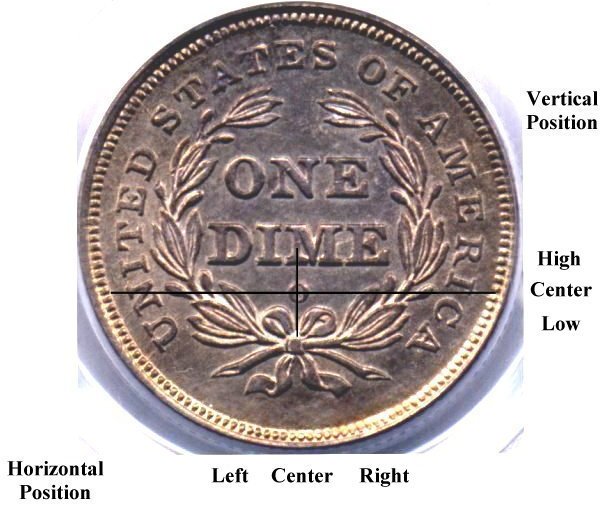
Examples of the Mintmark Position Guide Usage
Open Bud Reverses
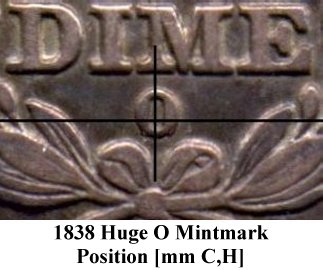
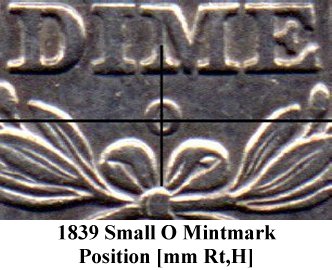
Mintmark Position Guide - Open Bud Reverses
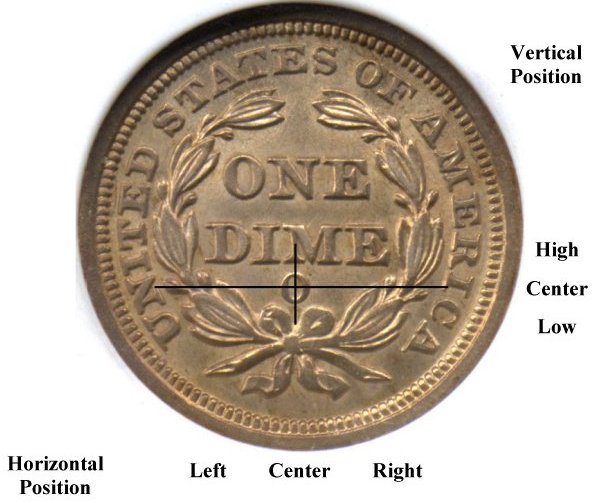
Examples of the Mintmark Position Guide Usage
Open Bud Reverses
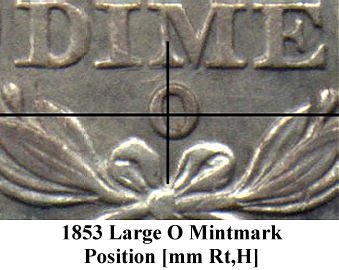
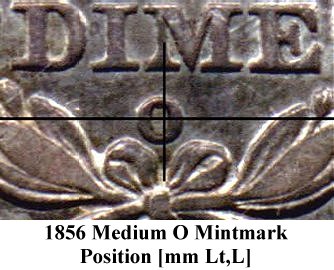
Cereal Wreath Reverses
For dies with a mintmark within the wreath, the four quadrant system is again used by positioning horizontal and vertical lines across the reverse. The horizontal line is positioned with the wreath from the innermost tip of the maple leaf on the left to the innermost tip of the oak leaf on the right. The vertical line is extended down the center of the left upright of the M, through the mintmark and into the bow knot.
Mintmark Position Guide - Mintmark In Wreath
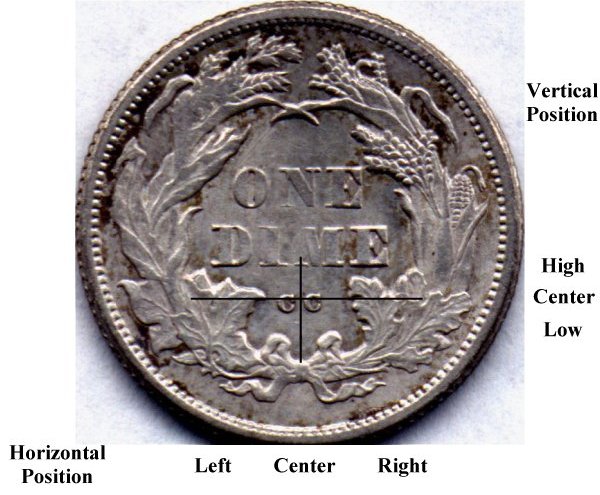
Examples of the Mintmark Position Guide Usage
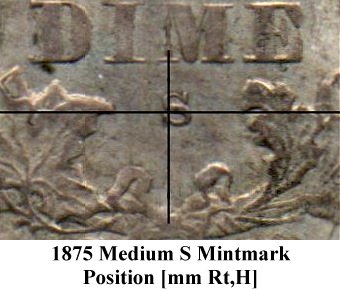
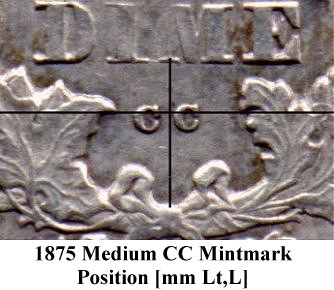
For dies with the mintmark placed below the wreath, the horizontal line is sighted at the bottom edge of the right ribbon end and extended across to the left ribbon end. The vertical line is centered within the bow knot and extended down to the denticles at the lower right. The vertical line should always fall between two denticles on the rim if it is well centered with respect to the bow knot. For digital image measurements, I have found that it is better to start the vertical line between the two denticles at the rim and then extend it upward to the bow knot.
Mintmark Position Guide - Mintmark Below Wreath
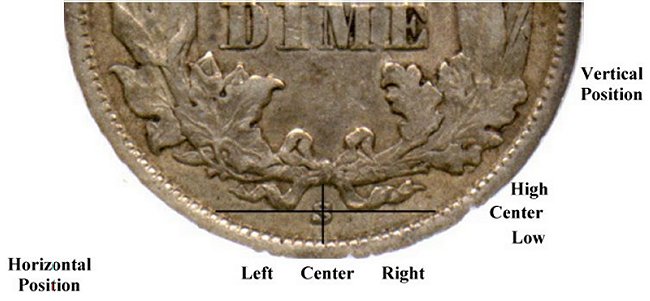
Examples of the Mintmark Position Guide Usage
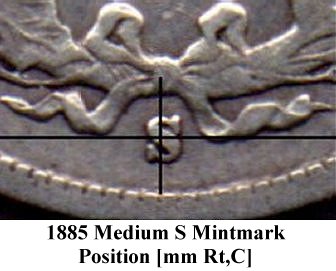
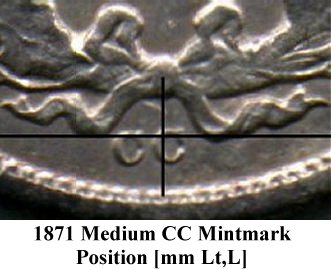
This concludes the presentation of the four quadrant system for measuring mintmark placement position. Variety collectors are encouraged to practice this technique through simple sightings with seated dimes within their collection. This technique can be used with digital imaging software for producing highly repeatable measurements.
Determining Mintmark Slopes
The tilt of a mintmark can be determined visually. An imaginary center line is sighted through the mintmark and the direction of the tilt is recorded as Tilted Left (TL) or Tilted Right (TR). This measurement technique is subjective and does not identify of the amount of tilt. I have used the picture scan rotation capabilities of digital image processing software to quantify the amount of mintmark tilt in either the left or right directions. The measurement is expressed in circular degrees and supplements the mintmark tilt identification as [mm Tilt, direction, number of degrees]. For example, a mintmark that tilts to the right and is 7 degrees from vertical would be labeled [mm TR7]. This methodology of mintmark tilt is demonstrated for examples of a reverse die paired with the 1857-O doubled die obverse.
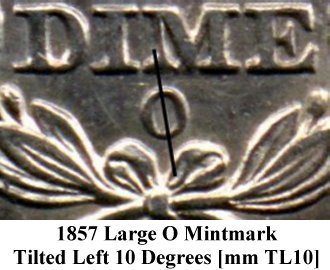
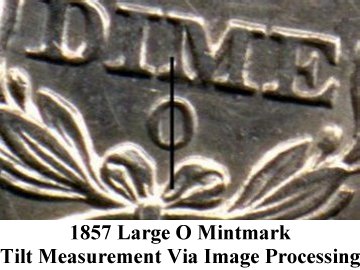
Additional examples mintmark tilt measurement and recording technique are presented for Carson City and San Francisco mintmarks located below the wreath.
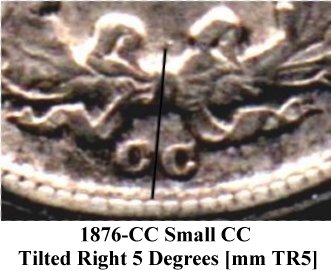
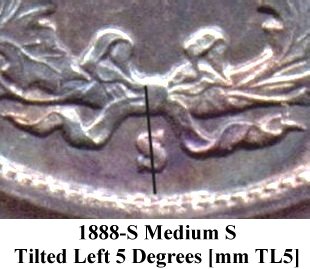
This concludes the discussion of the mintmark tilt measurement technique employed within the Date and Mintmark Varieties Analysis chapter.